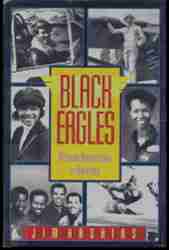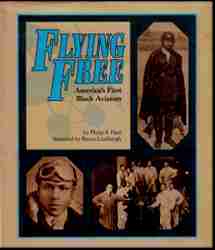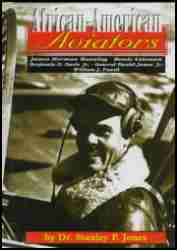
1899-1933 |
 |
|
J. Herman Banning was born in 1899 in Oklahoma, the son of Riley and Cora Banning. The family moved to Ames in 1919, where
Herman studied electrical engineering at Iowa State College for a little more than a year after which he "became air-minded." He learned
to fly at Raymond Fisher's Flying Field in Des Moines and became the first black aviator to obtain a license from the U. S. Dept. of
Commerce. Banning operated the J. H. Banning Auto Repair Shop in Ames from 1922 to 1928 (first, at 909 West Second Street, then at
912 Fourth Street). He left Ames to live in Los Angeles in 1929 where he was the chief pilot for the Bessie Coleman Aero Club, named
after a pioneer black woman flyer. Farwell T. Brown Photographic Archive Ames Public Library Information Services 515 Douglas Avenue Ames, IA 50010-6215 (515) 239-5656 |
by Richard W. Jackson Cause of death: plane crash |
 |
|
James Herman Banning's plane "MISS AMES" -- "FLY WITH BANNING" inscribed on side. Banning is seen in second seat of two-seater
Hummingbird bi-plane. Banning performed in air circuses, flew politicians during their campaigns. (One of his passengers was Illinois representative
Oscar Depriest, the first black person elected to serve in U. S. Congress since the Civil War.) (See also: 71.364D.1) Farwell T. Brown Photographic Archive Ames Public Library Information Services 515 Douglas Avenue Ames, IA 50010-6215 (515) 239-5656 |
 |
 |
|
African Americans in Aviation by Jim Hastings "African-American folklore is rich in stories and songs about people flying. But in the early days of American aviation, racism forced blacks to go to Europe to earn their wings. Such pioneers included Eugene Bullard, who joind the French Foreign Legion in 1914 and was awarded the highest honor given by the French military. In 1921 in France, daredevil Bessie Coleman was the first black American woman licensed as a pilot." |
America's First Black Aviators by Philip S. Hart In Flying Free, you'll learn how black pilots of the 1920s and 1930s overcame obstacles. Black aviators started their own flight schools, put on air shows, flew cross-country, and persuaded the military to train black soldiers for aviation combat." |
 |
 |
HALLELUJAH FLIGHT A NOVEL JACK LYNN |
Aviators Image courtesy of Richard W. Jackson |
 |
THE HALLELUJAH FLIGHT
Phil Bildner & John Holyfield Product Details Reading Level: 4-8 Hard Cover: 32 pages; 10.2 x 9.5 x 0.5 inches Publisher: Putnam Juvenile (January 7, 2010) List Price: $16.99 Your Price: $11.55 ISBN-10: 0399247890 ISBN-13: 978-0399247897 |
|
Editorial Reviews from Amazon.com From School Library Journal "Great as a read-alone as well as for telling aloud, this story serves to rescue two worthy men from historical obscurity. Students would benefit from knowing about them and their "Hallelujah Flight." (starred review) From Booklist In 1932, James Banning was the first African American to complete a transcontinental flight. Told from the viewpoint of his young copilot and mechanic, Thomas Allen, this dramatic picture book relates of their historic journey, in which they flew in a small plane from Los Angeles to New York in 21 days. Unframed, double-page paintings show the pair close-up in the cramped cockpit as they fly over the Grand Canyon and head into storms, the propeller whirring, while the ground passes not too far below. Some locals help, showing the kindness of family and friends, but the dramatic pictures also reveal the prejudice the pilots encountered when they are refused use of washrooms and restaurants. Finally, they reach New York and receive a heroís welcome in Harlem. Along with the drama of the pioneer flight, kids will also enjoy the irreverent fun of the Flying Hoboes in their flying jalopy. The story of the pilotsí bonding is as memorable as the breakthrough flight. An introductory authorís note offers cultural and historical context. Grades K-3. --Hazel Rochman |
|
TRAIL BLAZER KILLED AS PLANE CRASHES IN WEST White Aviator At Controls When Ship Went Into Tail- spin--2,000 Spectators Witness Tragedy--Feared He Was Not A "Capable Pilot", White Instructor Who Refused Him Airplane, Says. The heroic young flyer was killed when a Travelair two-seater plane, in which he was a passenger, went in to a tailspin after climbing 400 feet from the takeoff and crashed at Camp Kearney. The plane was piloted by Albert Burghardt (white), 30, aviation machinist mate, second class, from San Diego Naval Air Station. Burkhart was perhaps fatally injured. For Banning, who had crossed the country in a plane whose motor was eight years old; Banning, who had obtained his transport pilot's license down in Texas where a Negro had to take two tests--one for being a black man and the other to prove his skill in aviation; Banning, who had received nothing but the praise of veteran aviators all along the route on his epochal flight, was refused the use of an airplane by the Airtech Flying school here today, because the flying school instructor claims he did not believe him to be a capable pilot. Victim of a prejudice as old as the nation itself, Banning went to his death today without a fighting chance to save his life. Went to his death with an aviation machinist mate, second class, at the controls! A crowd of more than 2,000 people had turned out to witness the "air circus" Banning had advertised and stood stunned in silence as the Travelair hurtled to the earth and cracked up. Banning was gently lifted from the wreckage of the plane and rushed to the County Hospital where he died an hour after the crash, without having regained consciousness. Death was attributed to a fractured skull and internal injuries. The air circus here today, which saw the fatal crash, was conceived in an effort to obtain funds to return East and to secure his plane which had been forced down near Hiattsville, Pa. a couple of months ago. At the time of the forced landing, Banning, along with his partner and mechanic, Thomas C. Allen, Alhambra, Calif. youth, was returning to California. Efforts on the part ot the pair to obtain sufficient funds to repair their machine and continue on their way were unavailing, and they returned home to.......... Farwell T. Brown Photographic Archive Ames Public Library Information Services 515 Douglas Avenue Ames, IA 50010-6215 (515) 239-5656 |
|
If you have any more information on this Early Flier, please contact me. E-mail to Ralph Cooper 

|